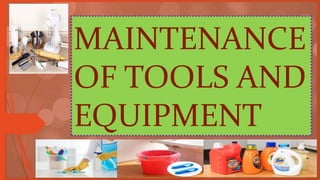GRADE 8 TLE LESSON 2
- 2. 1. ASBRASIVE CLEANERS – used to remove heavy accumulations of soil that are difficult to remove with detergents. 2. ACID CLEANERS – used periodically on mineral deposits and other soils that detergents cannot remove. 3. SOAP AND DETERGENT – cleaning agents help water to emulsify fats and to suspend soil particles. 4. SOLVENT CLEANERS – used occasionally on surfaces where grease has burned on often called degreasers. 1. CLEANING – first step to remove all organic materials. 2. WASHING – the most time consuming of the entire process. 3. RINSING – it is important to remove most of the suspended soil, bacteria and cleaning compounds from the equipment and utensils that are not removed from the previous step. 4. SANITIZING – the critical step in the cleaning process that requires knowledge in science. TYPES OF CLEANING AGENT FOR CLEANING STEPS IN THE CLEANING PROCESS
- 3. HEAT – in this method, hot water is an effective, nonselective sanitization for food-contact surfaces. STEAM – is an excellent agent for treating food equipment. CHEMICALS – destroy or inhibit the growth of micro organisms. CHLORINE – chemical used to kill germs and used water purification and disinfectant. IODOPHORS – these are soluble complexes of iodine combined usually with non-ionic surface active-agents loosely bound. QUATERNARY AMMONIUM COMPOUNDS – these are compounds that are synthetic surface-active agents. METHODS FOR THE FINAL SANITIZATION MOST COMMONLY USED CHEMICAL SANITIZERS
- 4. 1. After cooking soak all cooking utensils in a tub of warm water. 2. Put on the cleaning gloves. Scrape off any excess debris from the appliances or equipment with a scrubber sponge or scraper into the garbage disposal or trash can. 3. Remove stains from the equipment if necessary. 4. Sanitize the kitchen equipment. 5. Store the equipment. 6. Store your knives safely in butcher’s block or drawer, putting them away right after washing. 7. Keep your cutlery clean, but never toss a blade into a sink or wash basin in case someone reaches unaware into the dishwater. 8. Put frequently used items in conveniently accessible locations. 9. Proper storage and handling of cleaned and sanitized equipment and utensils is very important to prevent recontamination prior to use. 10. Cleaned and sanitized equipment and utensils must be: A. stored on a cleaned surfaces; and B. handled to minimize contamination of food contact surface. HOW TO CLEAND STORE COOKING TOOLS AND EQUIPMENT
- 5. 1. Prepare your cleaning materials. 2. Throw away trash, collect and put away objects that belong in some other rooms. 3. Fill the sink with water and bubbles. 4. Put the dishes in their proper place. 5. Clean the oven first so that any smoke or fumes are removed from the kitchen by frequent cleaning. ABRASIVE – a substance used for smoothing or polishing. CONTAMINATED – to make unfit for use by the introduction of unwholesome or undesirable elements. SANITIZER – a chemical agent used for cleaning and sanitizing surfaces and equipment. SANITIZING – process of removing potentially harmful micro organisms from a surface or an object. CLEANING – is the process of removing soil or residue from a particle surface with the use of soap products and detergents. CHLORINE – a halogen element that is isolated as a heavy greenish-yellow diatomic gas of pungent odor and used especially as a bleach, oxidizing agent and disinfectant in water. GROUT – a thin mortar for filling joints between tiles, masonry and others. TECHNICAL TERMS CLEANING THE KITCHEN




